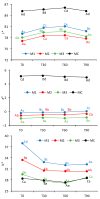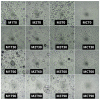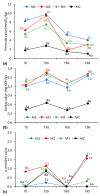Development, Characterization, and Stability of Margarine Containing Oleogels Based on Olive Oil, Coconut Oil, Starch, and Beeswax
- PMID: 40710675
- PMCID: PMC12294439
- DOI: 10.3390/gels11070513
Development, Characterization, and Stability of Margarine Containing Oleogels Based on Olive Oil, Coconut Oil, Starch, and Beeswax
Abstract
The removal of partially hydrogenated fats, as well as the substitution of saturated fats with healthier alternatives, has become increasingly common due to their well-established association with adverse health effects. As a result, the demand for alternative formulations in the food industry has driven the development of a promising emerging technology: oleogels. Oleogels are a semi-solid material made by trapping liquid oil within a three-dimensional network formed by structuring agents. Within this context, this study aimed to develop and characterize margarines prepared with oleogels formulated from extra virgin olive oil, coconut oil, starch, and beeswax at varying concentrations. The proposed oleogel-based formulations exhibited a high melting temperature range and lower enthalpy. Although lipid oxidation levels differed between the commercial and oleogel-based margarines, they remained within acceptable limits. A significant difference in color was observed, with the oleogel formulations imparting a slight greenish hue compared to the commercial margarine. In terms of microstructure, the commercial margarine presented smaller and more uniformly distributed water droplets. Oleogel-based margarines demonstrated technological feasibility. Considering consumers' growing interest in food innovation and health-conscious products, olive oil-based oleogel margarines represent a promising alternative, particularly due to the nutritional benefits associated with olive oil.
Keywords: beeswax; lipid oxidation; organogel; saturated fatty acid; trans-fatty acid.
Conflict of interest statement
The authors declare no conflicts of interest.
Figures







Similar articles
-
Evaluation of high oleic sunflower oil oleogels with beeswax, beeswax-glyceryl monopalmitate, and beeswax-Span80 in cookie preparation.J Sci Food Agric. 2023 Oct;103(13):6198-6207. doi: 10.1002/jsfa.12687. Epub 2023 May 17. J Sci Food Agric. 2023. PMID: 37140538
-
Oleogels: Uses, Applications, and Potential in the Food Industry.Gels. 2025 Jul 21;11(7):563. doi: 10.3390/gels11070563. Gels. 2025. PMID: 40710724 Free PMC article. Review.
-
Comprehensive Review on Oleogels Structured by Lipid-Based Compounds: From Structure Mechanisms to Nutritional Functionalities and Applications in Food Industry.Compr Rev Food Sci Food Saf. 2025 Jul;24(4):e70214. doi: 10.1111/1541-4337.70214. Compr Rev Food Sci Food Saf. 2025. PMID: 40588820 Review.
-
Characterization of improved sugarcane wax-based oleogels based on bovine bone proteins and their application as solid fat substitutes in cookies.Int J Biol Macromol. 2025 Aug;319(Pt 1):145385. doi: 10.1016/j.ijbiomac.2025.145385. Epub 2025 Jun 18. Int J Biol Macromol. 2025. PMID: 40541880
-
Evaluation of Frying Performance, Storage Stability, and In Vitro Digestion of Extra Virgin Olive Oil-Candelilla Wax Oleogel.J Food Sci. 2025 Jul;90(7):e70405. doi: 10.1111/1750-3841.70405. J Food Sci. 2025. PMID: 40641176 Free PMC article.
References
-
- de Oliveira Izar M.C., Lottenberg A.M., Giraldez V.Z.R., Santos Filho R.D.D., Machado R.M., Bertolami A., Assad M.H.V., Saraiva J.F.K., Faludi A.A., Moreira A.S.B., et al. Position statement on fat consumption and cardiovascular health-2021. Arq. Bras. Cardiol. 2021;116:160–212. doi: 10.36660/ABC.20201340. - DOI - PMC - PubMed
-
- Federal Register: Final Determination Regarding Partially Hydrogenated Oils. [(accessed on 7 May 2025)]; Available online: https://www.federalregister.gov/documents/2015/06/17/2015-14883/final-de.... - PubMed
-
- Dassanayake L.S.K., Kodali D.R., Ueno S., Sato K. Physical properties of rice bran wax in bulk and organogels. JAOCS J. Am. Oil Chem. Soc. 2009;86:1163–1173. doi: 10.1007/s11746-009-1464-6. - DOI
LinkOut - more resources
Full Text Sources
Research Materials

